
Big power and equally big aero are the two main attributes that any serious time attack car will require these days. If you want to go fast you need the power and if you have the power you need to be able to unleash it efficiently, so you can pack on the speed and hold as much of it through corners. Seeing the progression of the sport in the last few year has really been interesting, witnessing those lap times come down, being amazed at the seemingly impossible things that have been achieved, not to mention always wondering how it could all be improved upon. Now this all well and good but as a mere mortal with a limited budget and a little car project of my own happening on the side, most of these cars are just way too advanced.

That’s why it’s always been the more down to earth builds that have attracted me the most, ever since I started covering the Japanese tuning scene, and I think the car I have for you today is a perfect example of this. Plus, the fact that it’s an NSX makes it all the more special – still one of the most sought-after sports cars to come out of Japan and one that will forever have a special place in everyone’s hearts. This is one of Kakimoto Racing’s latest projects, a car we have seen slowly progress since spotting it for the first time a couple of years back at the Nagoya Exciting Car Showdown. Unfortunately, being based in Osaka, in the Kansai region of Japan, has meant that the Kakimoto crew never really takes the car up north and enters it in time attack events that we know and love, like the Super Battle and Battle Evome. So despite never having seen it in action, this is one car that has always interested me.
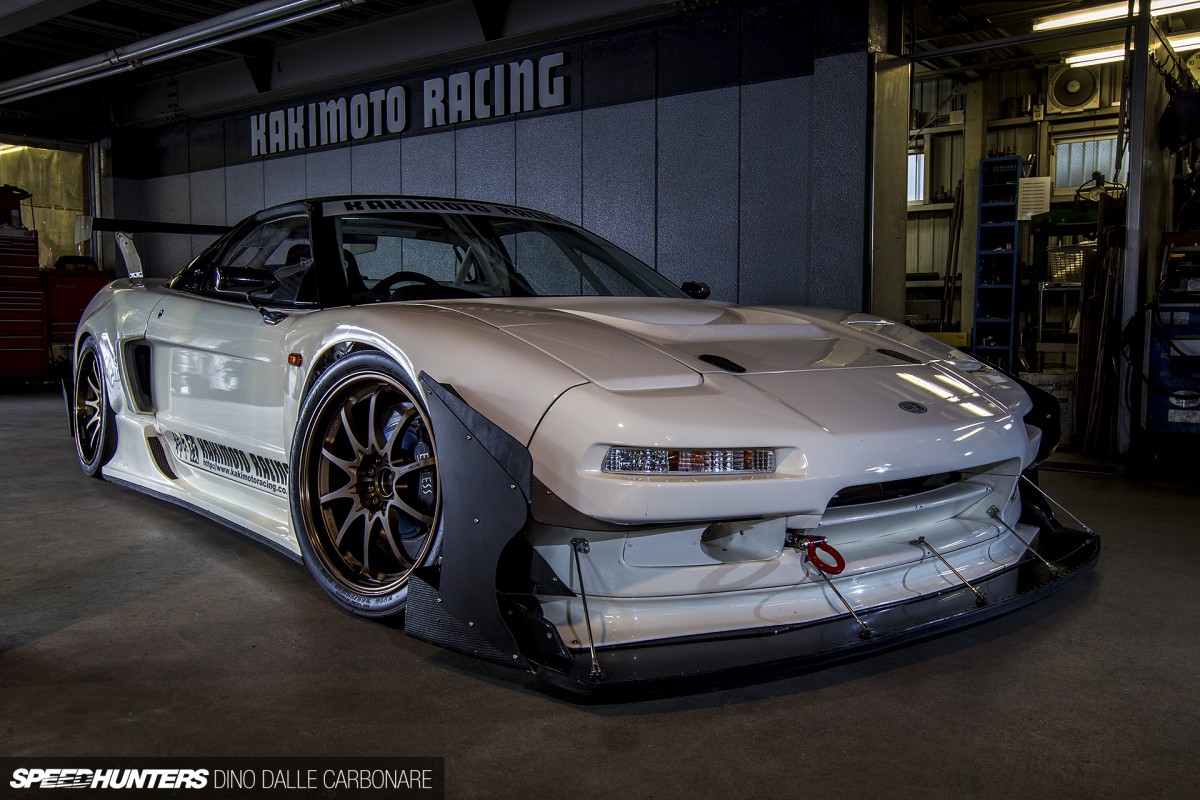
The way every single aspect of the car has been upgraded without meddling with the initial balance the NSX boasted when coming out of the Honda factory all those years ago, is to me something that really needs to be commended. Had they wanted to create a record breaker, they would have stripped it down, binned the engine and replaced it with something hugely powerful, mating it to a CFD-developed aero package, a motorsports derived driveline and wowed people in the process. But they didn’t, they kept it real for lack of a better word, in the process creating something just as equally awesome. Some of you are probably well aware that Kakimoto is one of the oldest exhaust manufacturers in Japan, but you probably didn’t know that they also built some wild high-speed and drag cars back in the day to develop their own engine products and miscellaneous upgrades. Exhausts is what they’re all about today, either off-the-shelf units or full custom builds which they can knock up in a couple of days for anyone that wants something special. But I’ll touch more on that in the shop tour I have coming this month, because it’s the NSX I want to concentrate on here, starting first with the body.
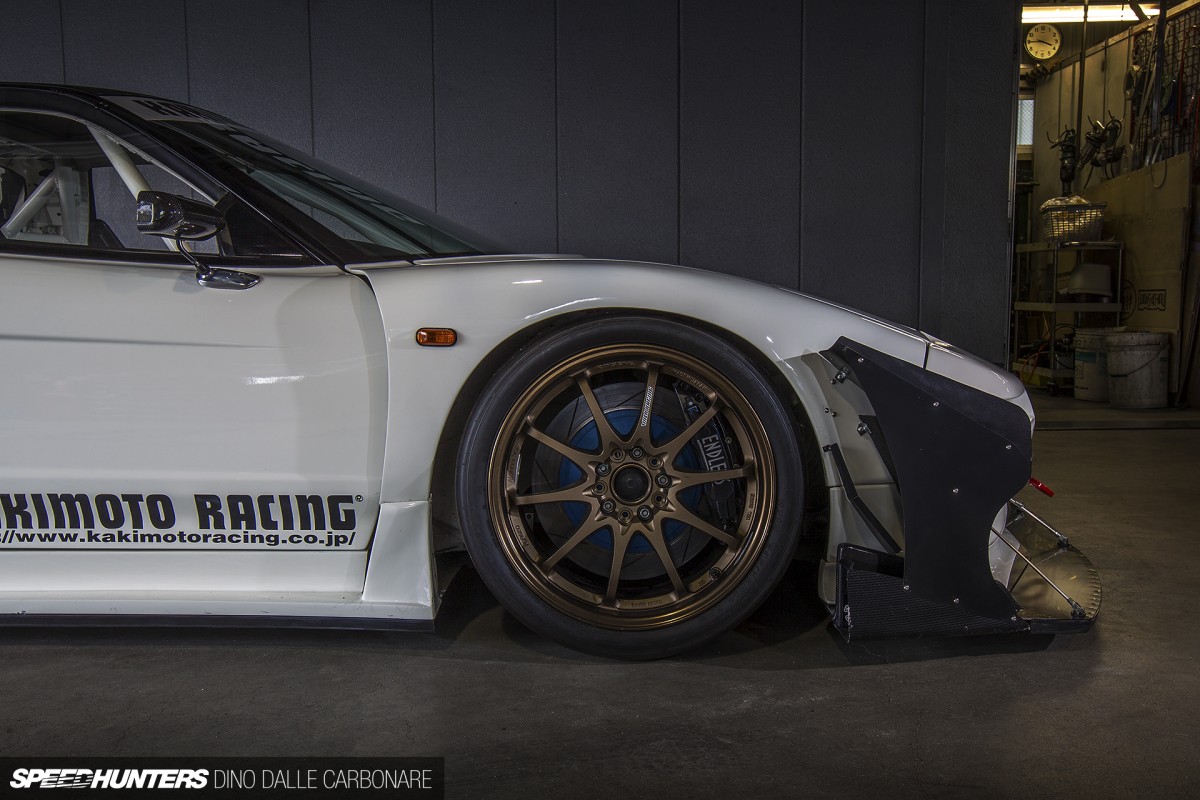
What makes this project all the more down to earth is that they never wanted to market any of their parts with it; that’s why the custom body that they created isn’t for sale – the panels were just one-offs for this car. I’m talking about things like the widened fenders, there to help them run the widest possible front and rear tracks.

Then there’s the carbon fiber front diffuser with an extended lip, held in place with a series of adjusters. This joins a pretty wild canard set-up, boxed at each side to help push the NSX’s front end down onto the tarmac and get it to bite down through even the more challenging turns.
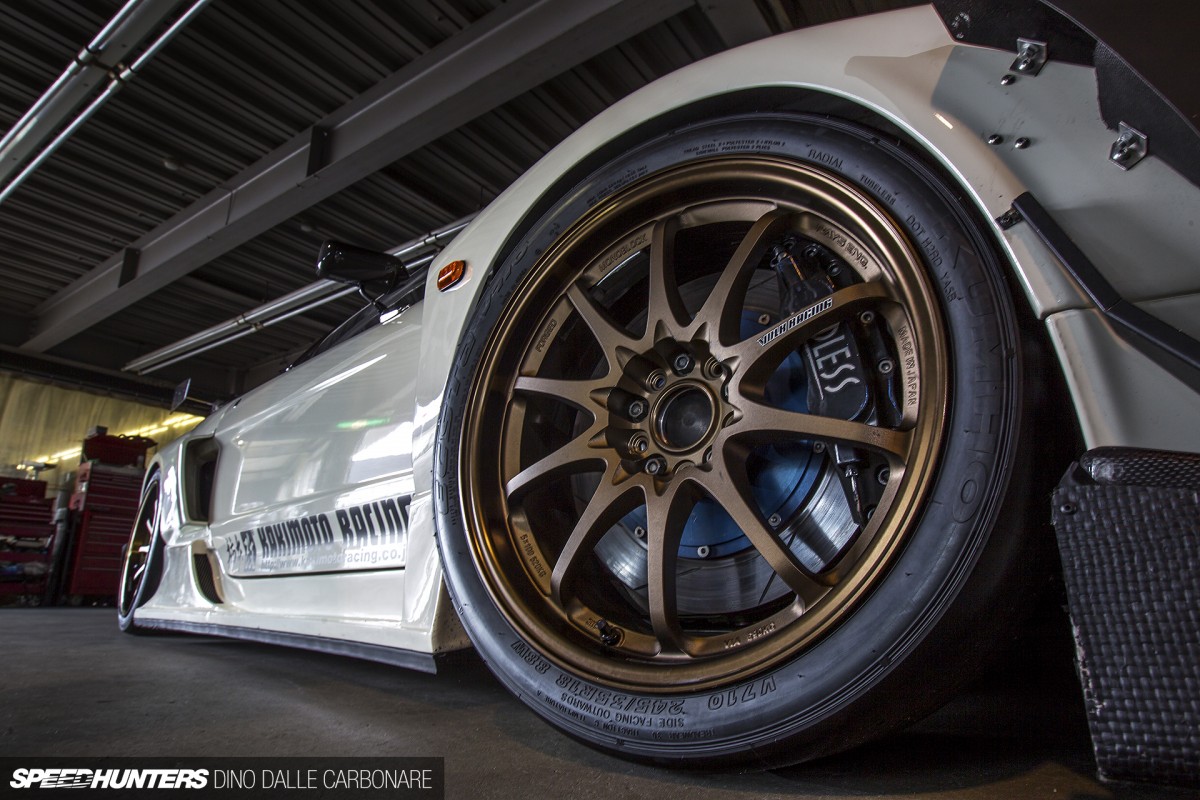
The RAYS Volk Racing CE28N and Kumho semi-slick wheel/tire combo provide the boost in grip, 245/35 on the 8.5″ wide eighteens at the front and 285/35 on 18×10.5 rears. Kakimoto adjustable dampers with 8.9kg/mm springs are used at the front, along with one-off adjustable A-arms that, much like everything else, were built in-house. But that’s just scratching the surface. You see, the NSX, during its initial development, had a bit of a crash which damaged the front end pretty badly. Rather than attempting to fix the aluminum chassis, Kakimoto decided to take advantage of it all and literally chopped off the front end of the car.
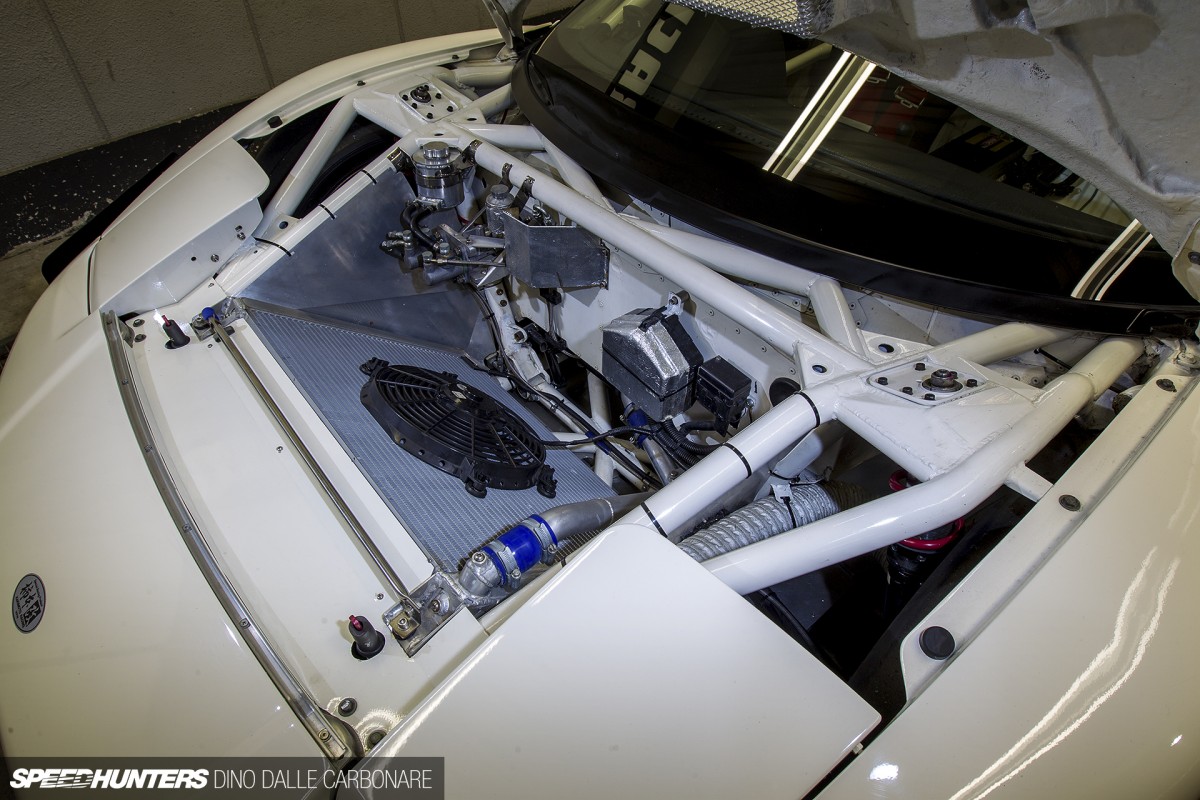
They fabricated a tubular frame instead, which allowed them to devise custom suspension pick-up points to get a more track-oriented geometry. Due to the fact that steel and aluminium can’t be welded together, the whole front end was bolted, bonded and riveted to the NSX’s lightweight chassis, something you can see very well by taking a look underneath the vented hood. That’s also where the ARC custom radiator sits, along with a small electric extractor fan.
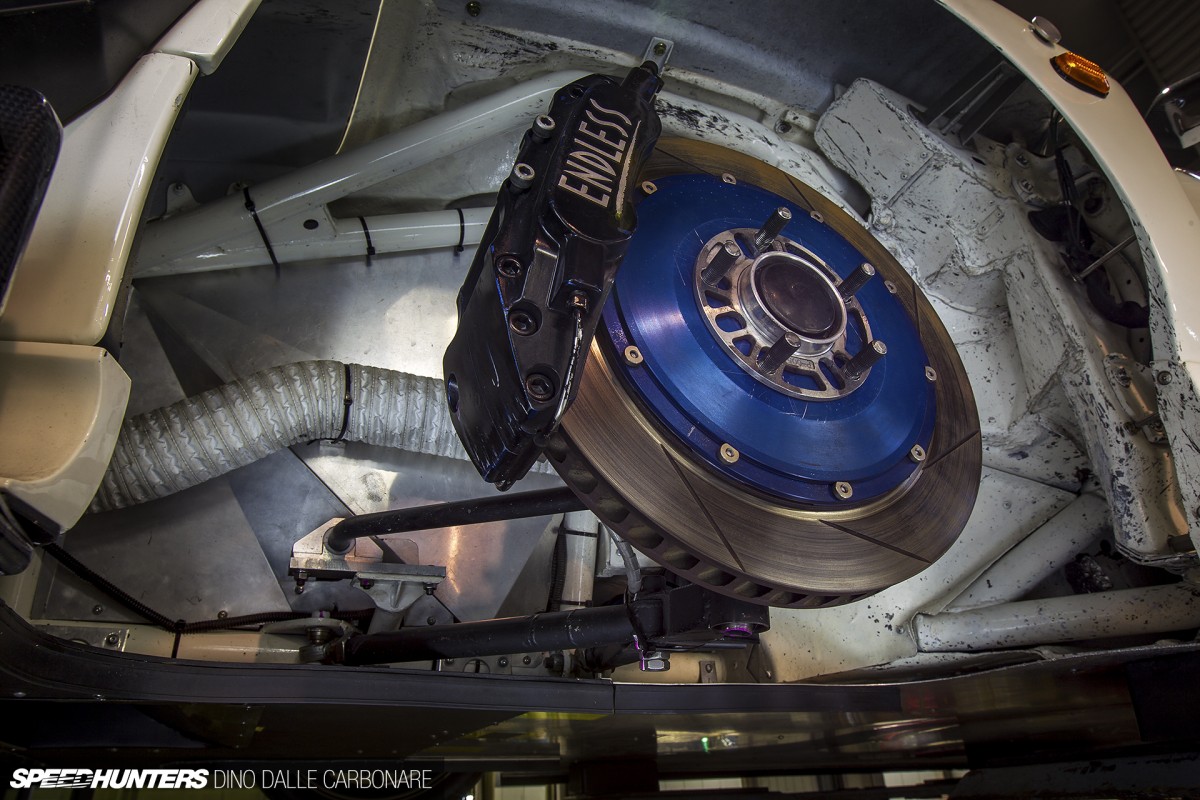
You can really appreciate the work from underneath the car: the custom sway bars, the rose-jointed links, the baffling and get a glimpse of how the front diffuser connects onto the rest of the underfloor. The stock NSX brakes were obviously not going to cut it, so Endless six-pots take care of shedding speed off quickly and effectively. Brake ducting makes sure these are also cooled well, so the middle pedal is always ready for action, no matter how many laps the car has been out on.
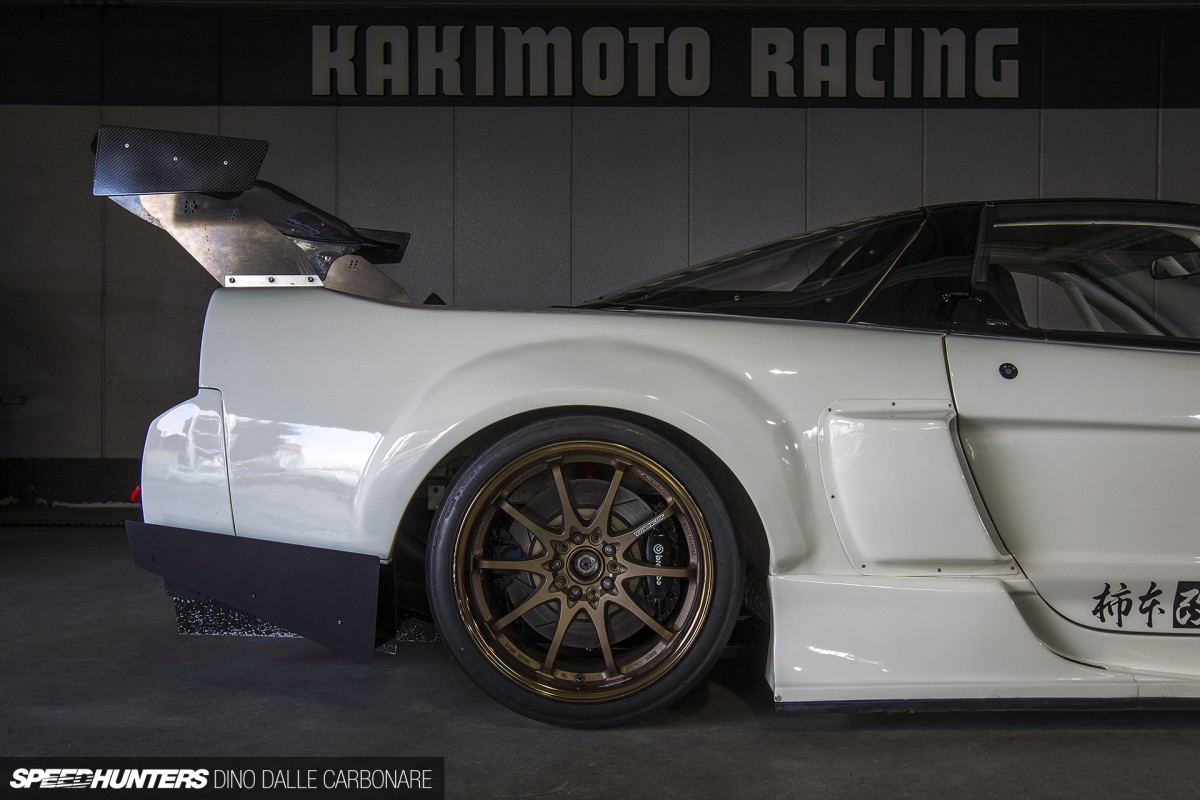
The blistered rear fenders give a very purposeful, almost GT-racer stance to the car, while the twin side air intakes have very important jobs to do, and that is feed air into the engine bay and keep the rear four-pot Brembo brake set-up within operating temperature. With decent levels of front downforce being generated at speed, coming up with a balanced set-up for the rear end was also high on the to-do list.
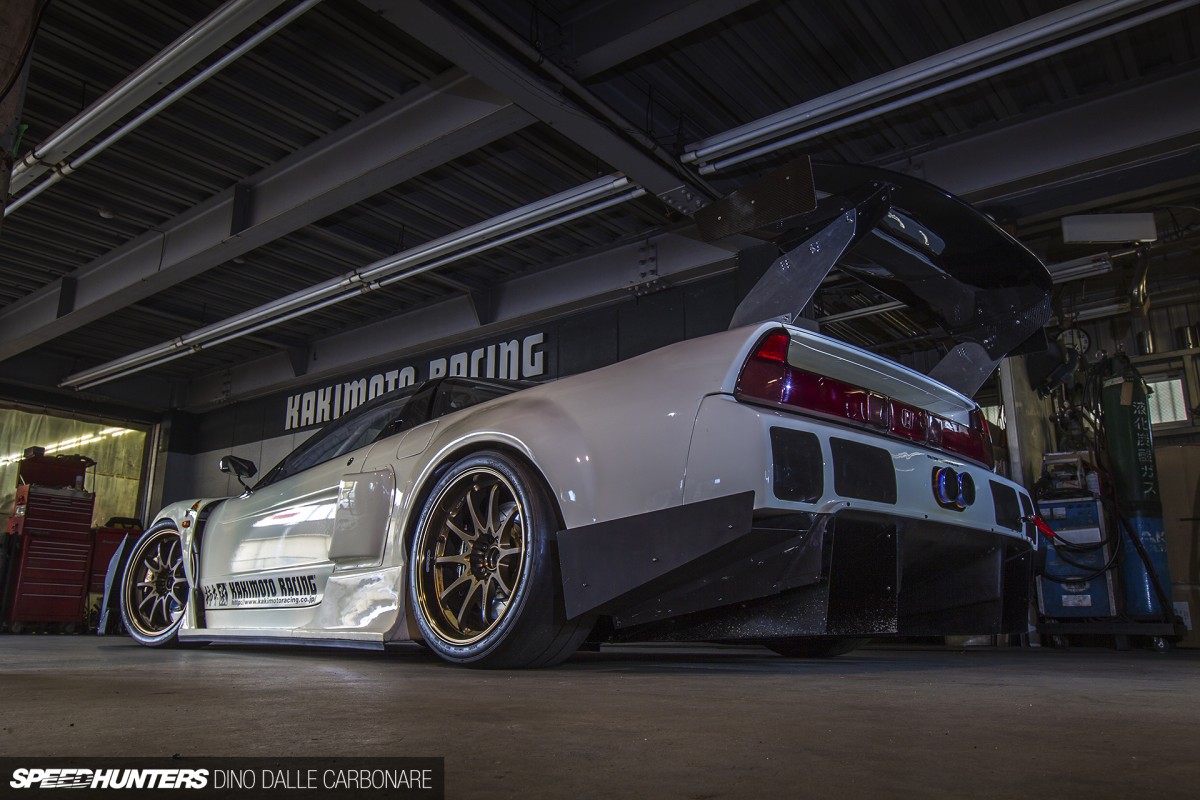
While the high-set rear GT-wing was there from day one, the rear diffuser and side canards came to be in a series of evolutionary steps, much like the extractors which have the delicate job of channeling out air from under the car and releasing it without causing any unwanted vortices. The four openings on the rear bumper add to this by further cutting down on drag. With the mid-engine layout and the high downforce generated, it was necessary to run very hard 23.2kg/mm springs on the rear Kakimoto dampers to take all that weight.
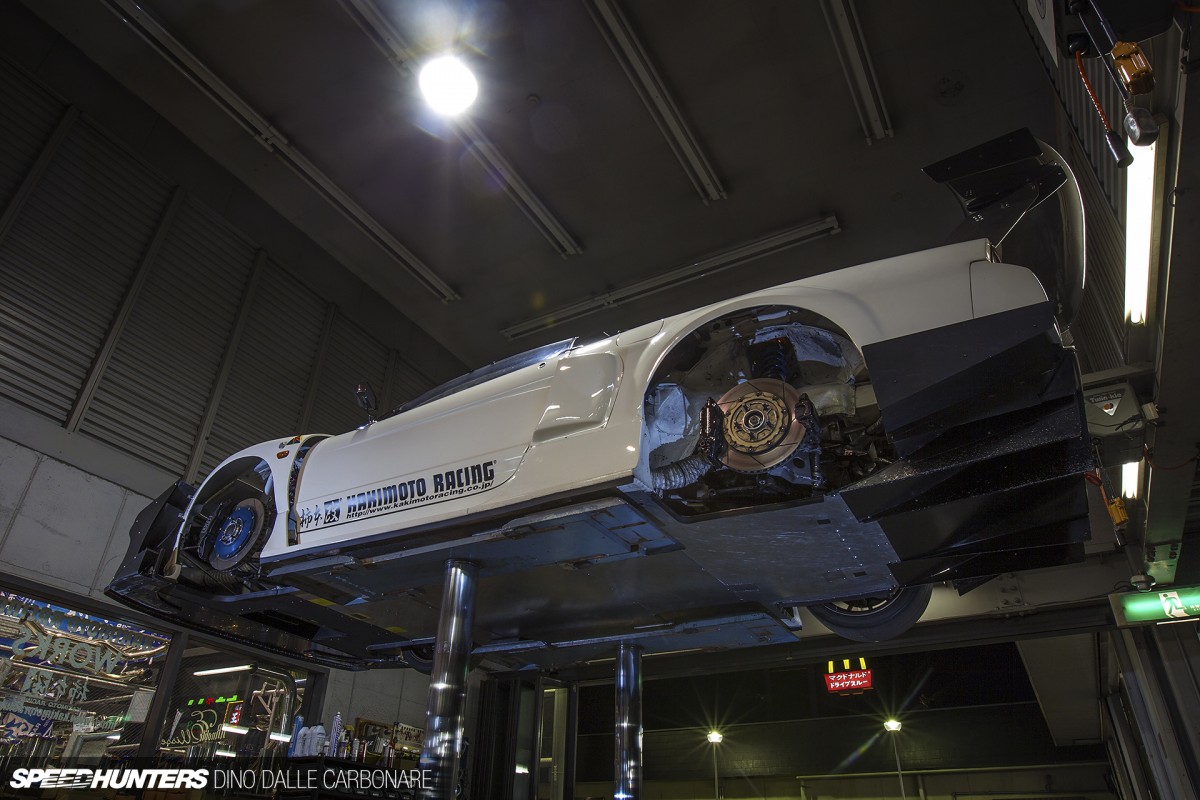
With the car lifted up in the air inside the Kakimoto garage, you can really see all the work that has been done to crate a functional underfloor set-up. It might not be as advanced as some other time attack cars out there, but it does its job very well.
Making aluminum stiffer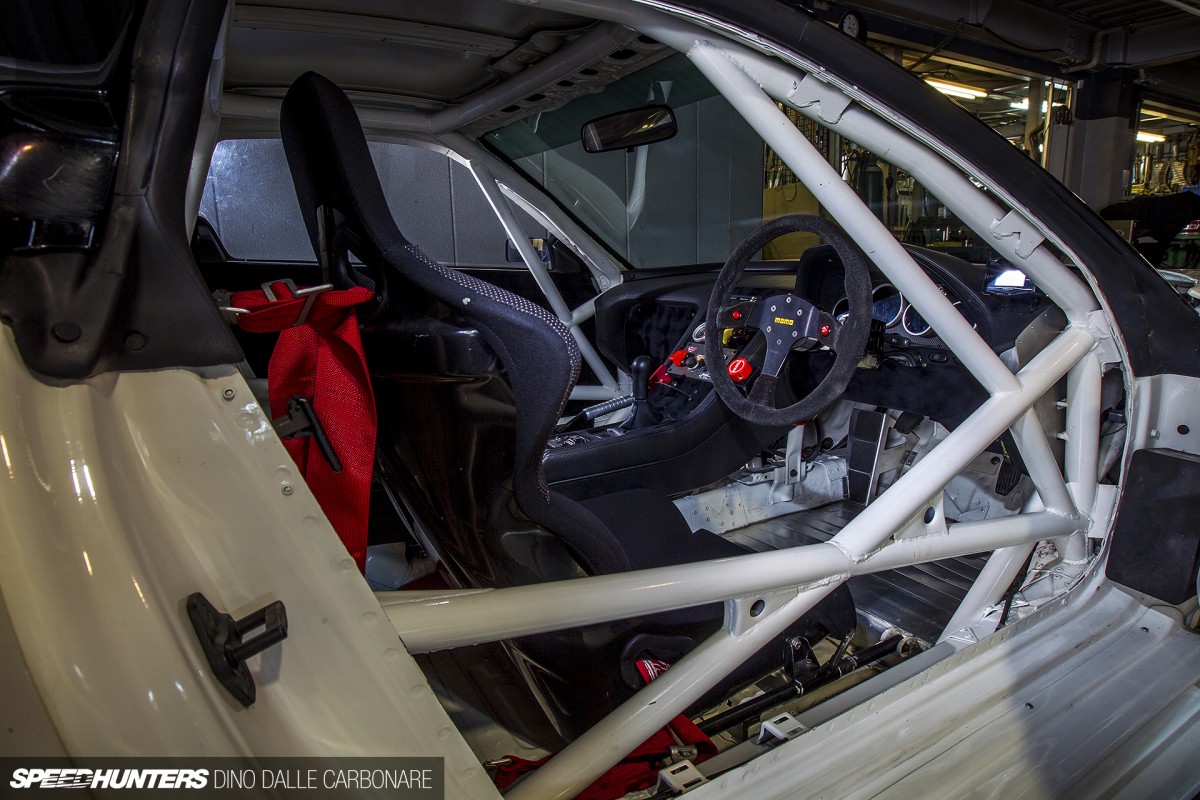
Swinging the paper-light driver’s side door open, it instantly becomes evident that making the car as stiff as possible was very much a goal of this project.
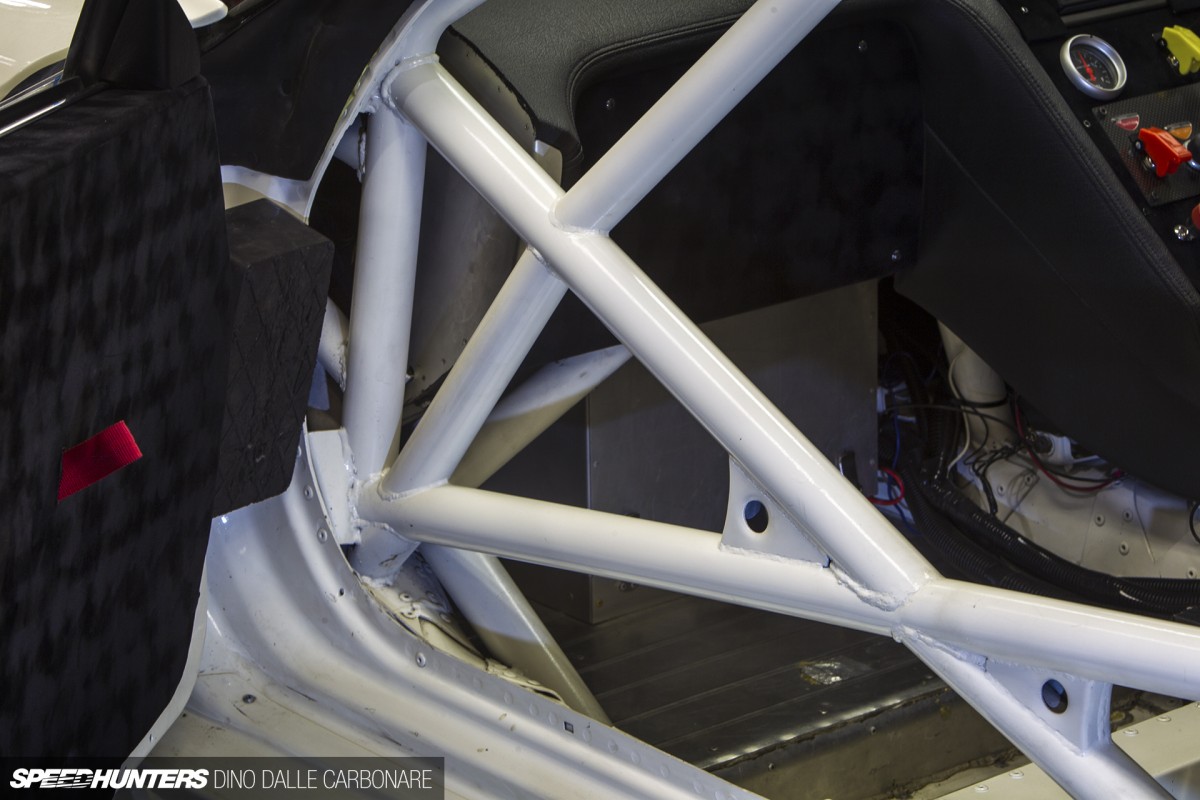
Much like the custom front end, the custom fabricated roll cage is riveted and bonded onto the chassis, with countless additional stiffening pipes further boosting its effect. It might have added some weight to the car, but the gains in rigidity more than make up for it.
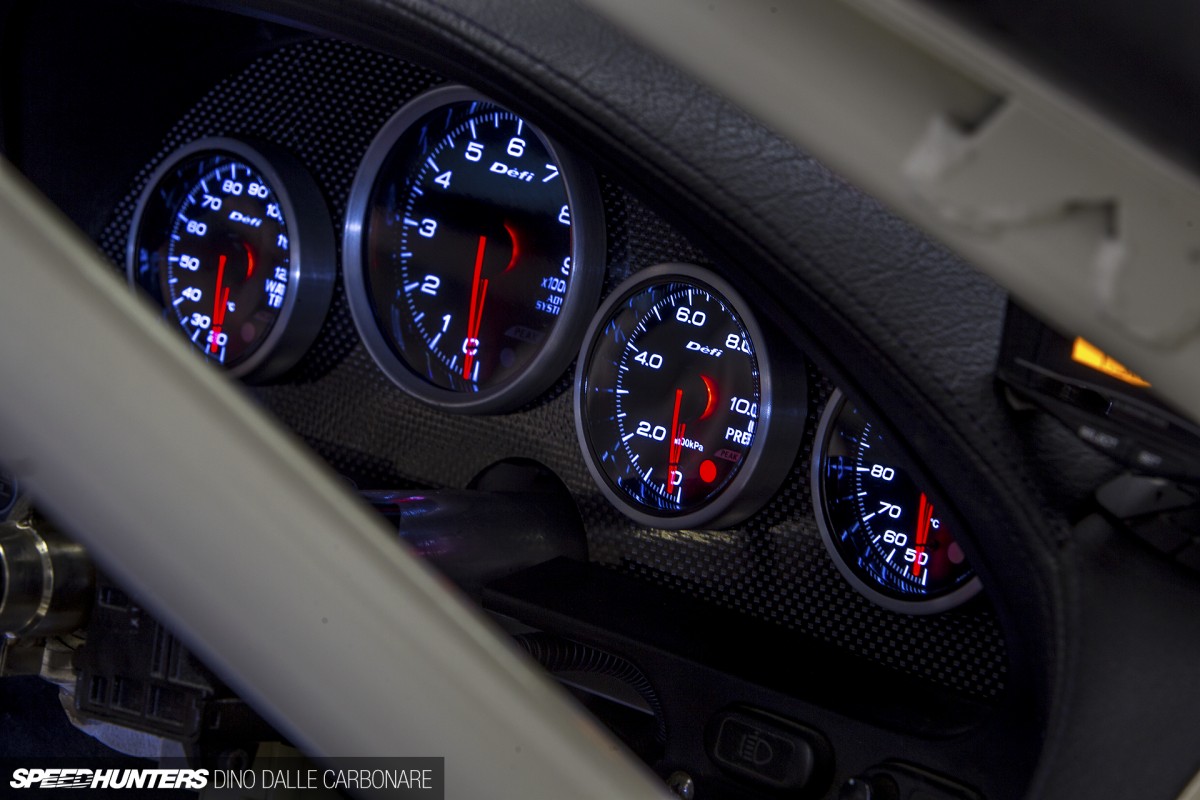
From the Recaro SP-G bucket seat, the driver has nicely laid out Defi instrumentation to play with, with the big easy-to-read tachometer taking center stage.
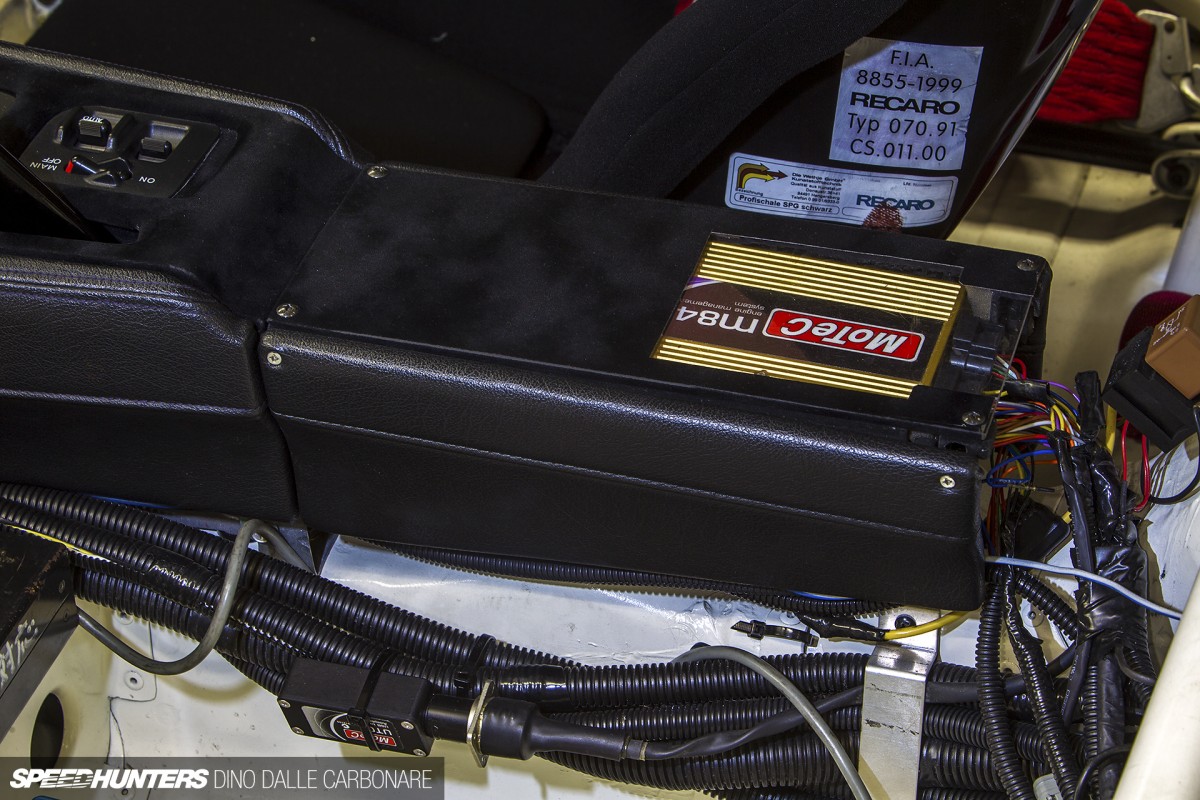
Custom wiring the Motec M48 ECU into place was a monumental job, but one that introduced countless benefits when it came to extracting the best out of the engine. But more on that on the next chapter…
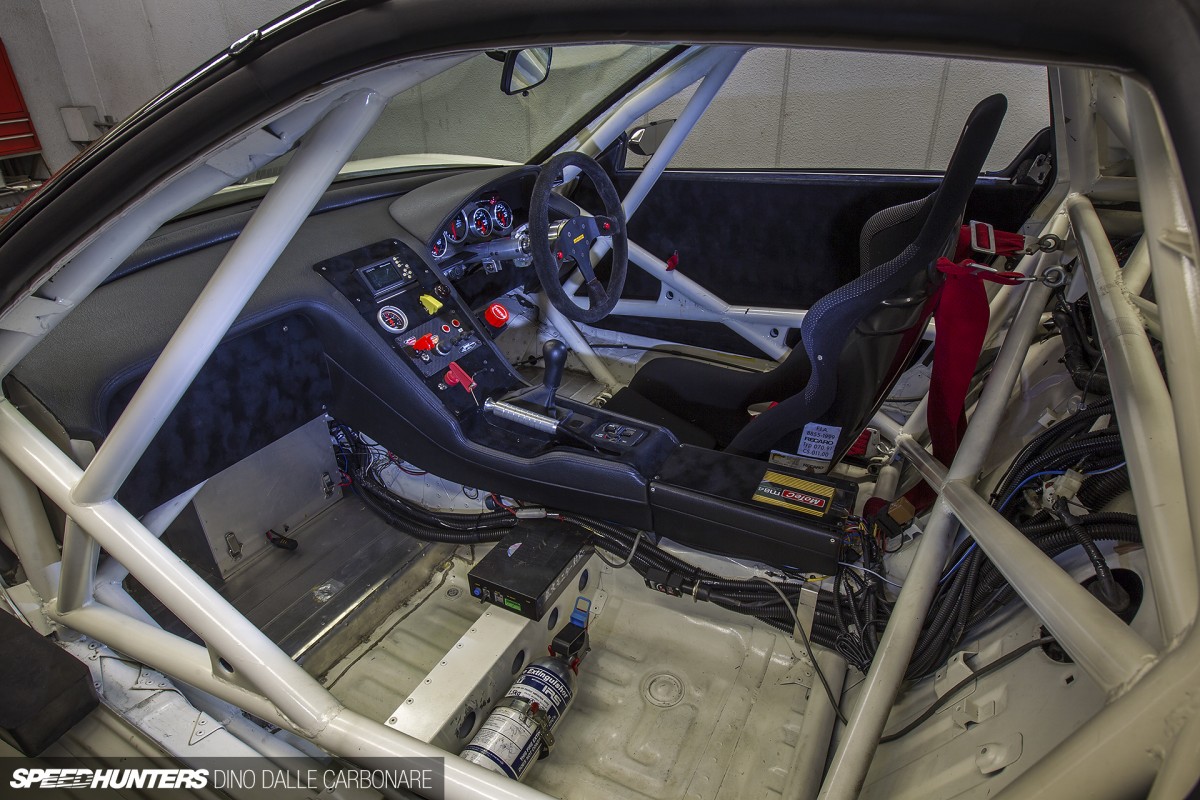
While the no-nonsense approach has made the cockpit all about functionality, the layout definitely has a coherence to it: the well-picked auxiliary instrumentation, the simple switch panel and the way exposed stripped areas are covered in a suede-like fabric to clean things up. It all makes for the sort of interior we’re not used to seeing on JDM cars, which for the most part tend to overlook the interior.
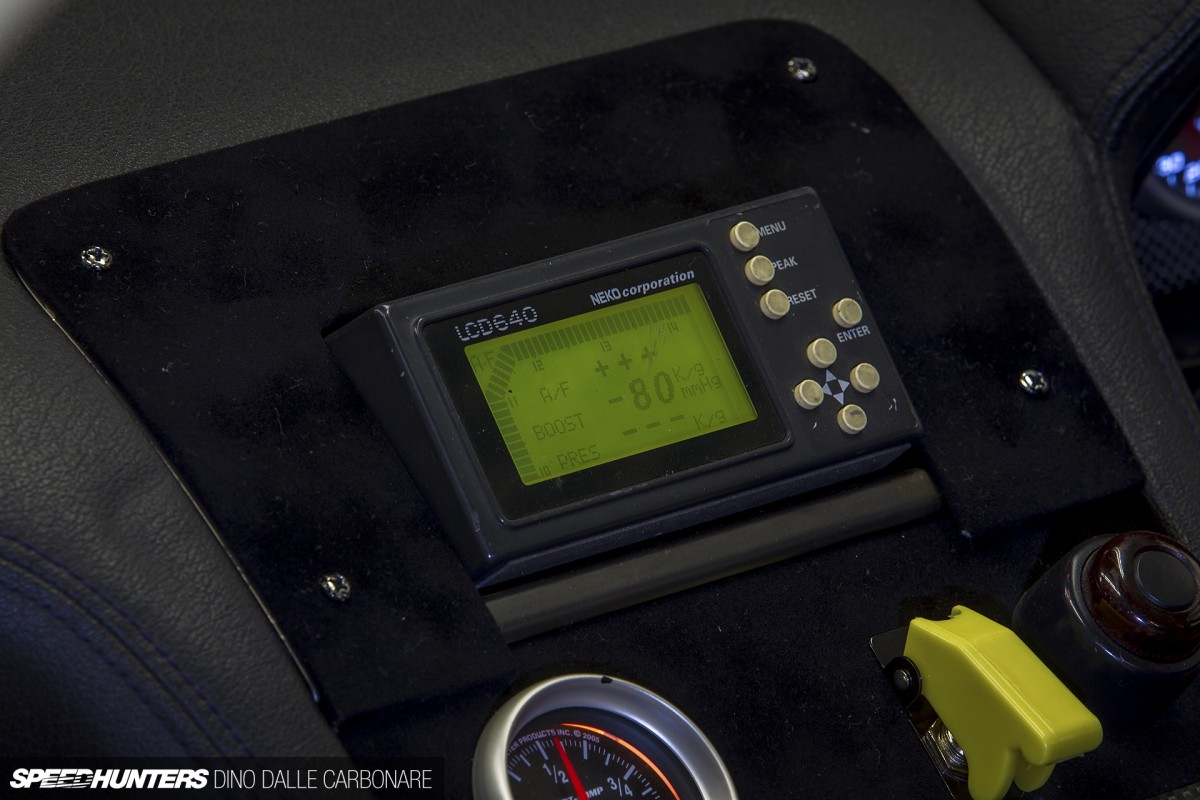
The Neko Corporation LCD640 may be an older unit, but it still does the job very nicely, displaying a variety of parameters from the ECU’s inputs and outputs. It’s main function in the NSX however is to display the air/fuel mixture.
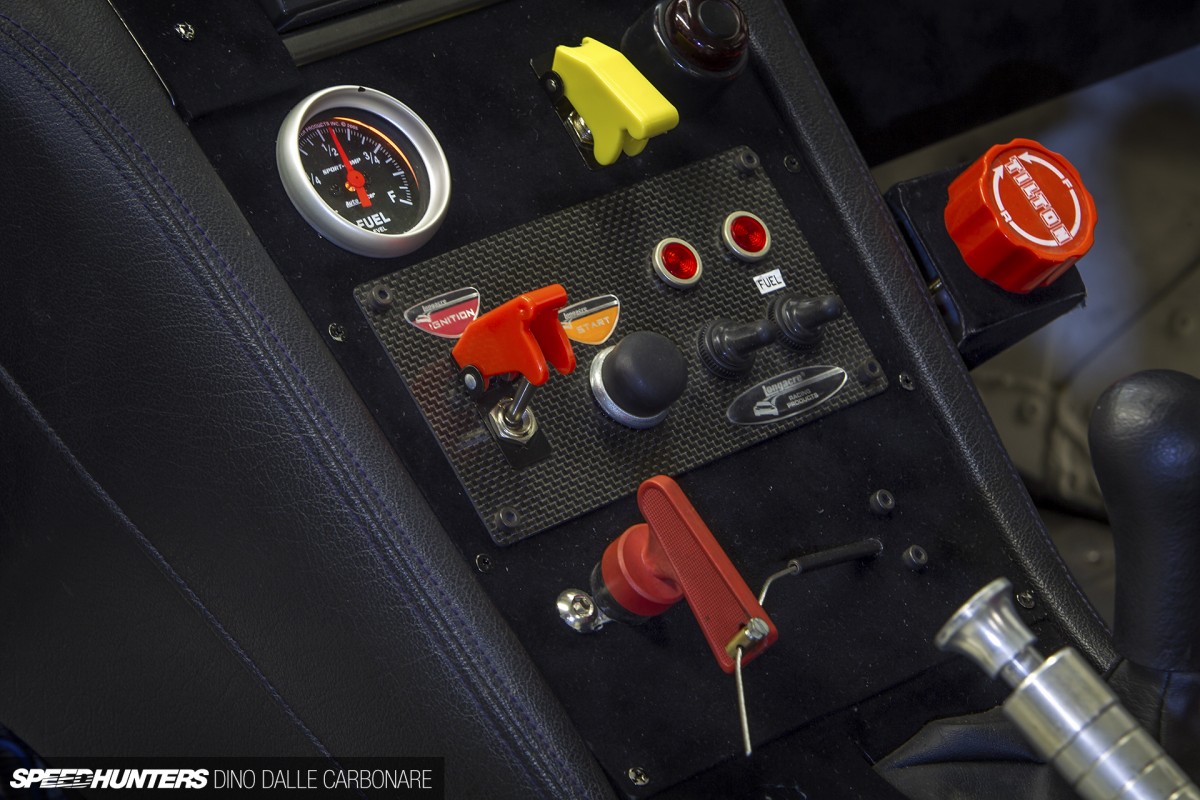
The car’s switchgear has been grouped where the A/C and audio controls used to once be, along with an Auto Meter fuel gauge and the cut-off switch for the electrics. You can also see the Tilton brake balance adjuster, useful for fine-tuning the car’s braking set-up depending on grip conditions and of course track layout.
Electrifying response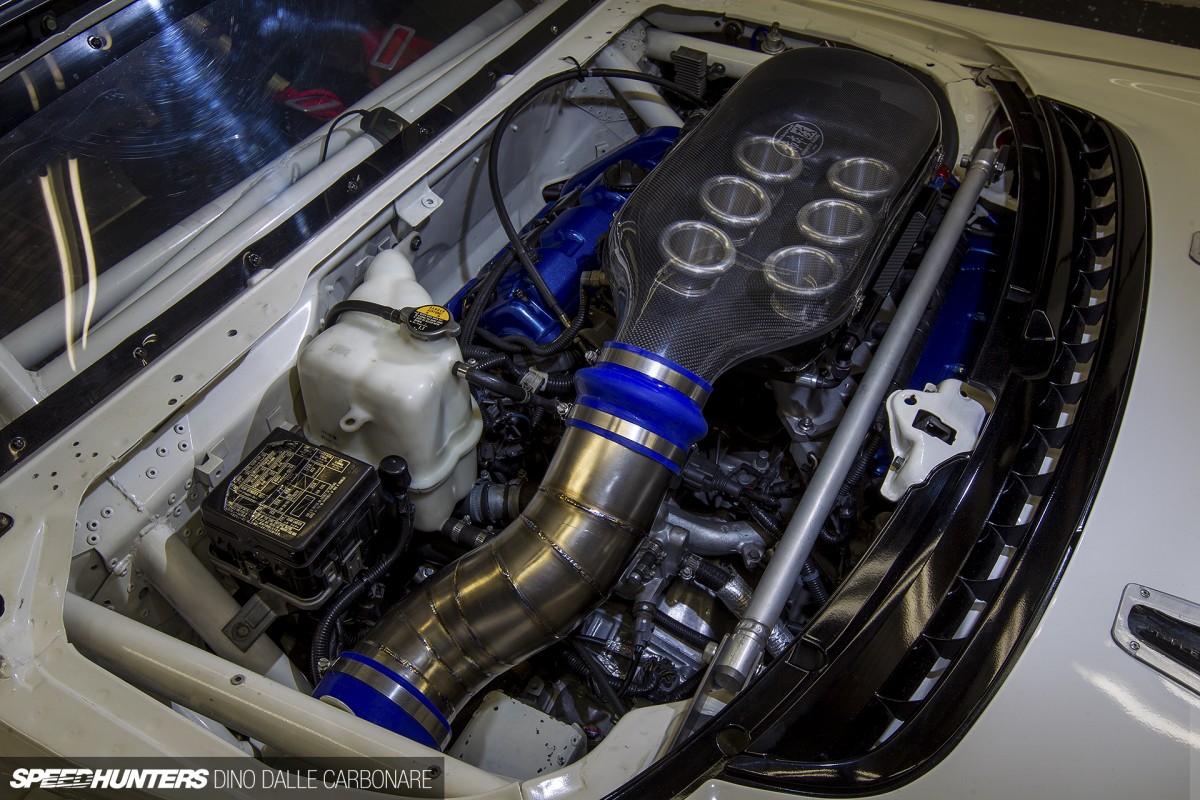
Lifting the lightweight lexan engine cover reveals the heart of the NSX. You won’t find any turbochargers or superchargers here, as force induction was just not a route that Kakimoto intended to take. The idea was to further improve the engine and create an optimal balance between power, torque and response and to get going, the C30A was plucked out of the engine bay and taken apart. The aluminum block was bored and honed so it could accommodate the slightly larger 92mm forged pistons, which would give a slight capacity increase to 3,110 cc. These are then connected up to the stock titanium conrods and crank, and balanced to very high tolerances to guarantee vibration free rotation all the way up to the 9,000 rpm redline. The intake and exhaust ports on the two heads were treated to a little polishing to smooth and increase flow, while intake valves and head gaskets from the later generation C32B engine were swapped over. Custom milled cams followed, sporting carefully profiled lobes for both the normal timing as well as the VTEC side, specially devised to take consideration of every upgrade carried out to the engine. Wanting to maximize the V6’s true potential, the stock single throttle set-up was just not going to cut it. ‘Electrifying response’ was a key goal so Kakimoto devised their own mechanical six-throttle set-up, each of the six cylinders breathing through individual 48mm tracts and short velocity stacks.
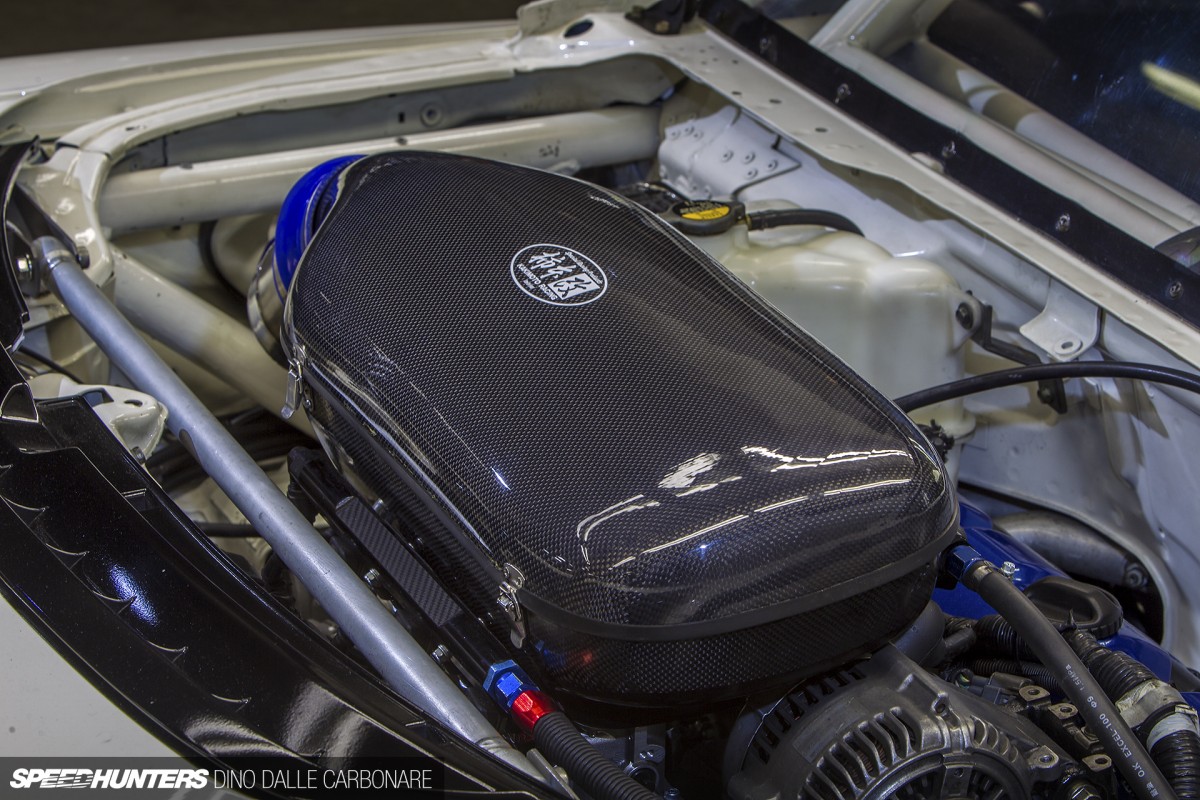
Mid-engine set-ups have an inherent problem of high engine bay temperatures with very little air to cool things down, so it’s not surprising that Kakimoto created a carbon airbox to keep the six velocity stacks shielded from under-hood temperatures.
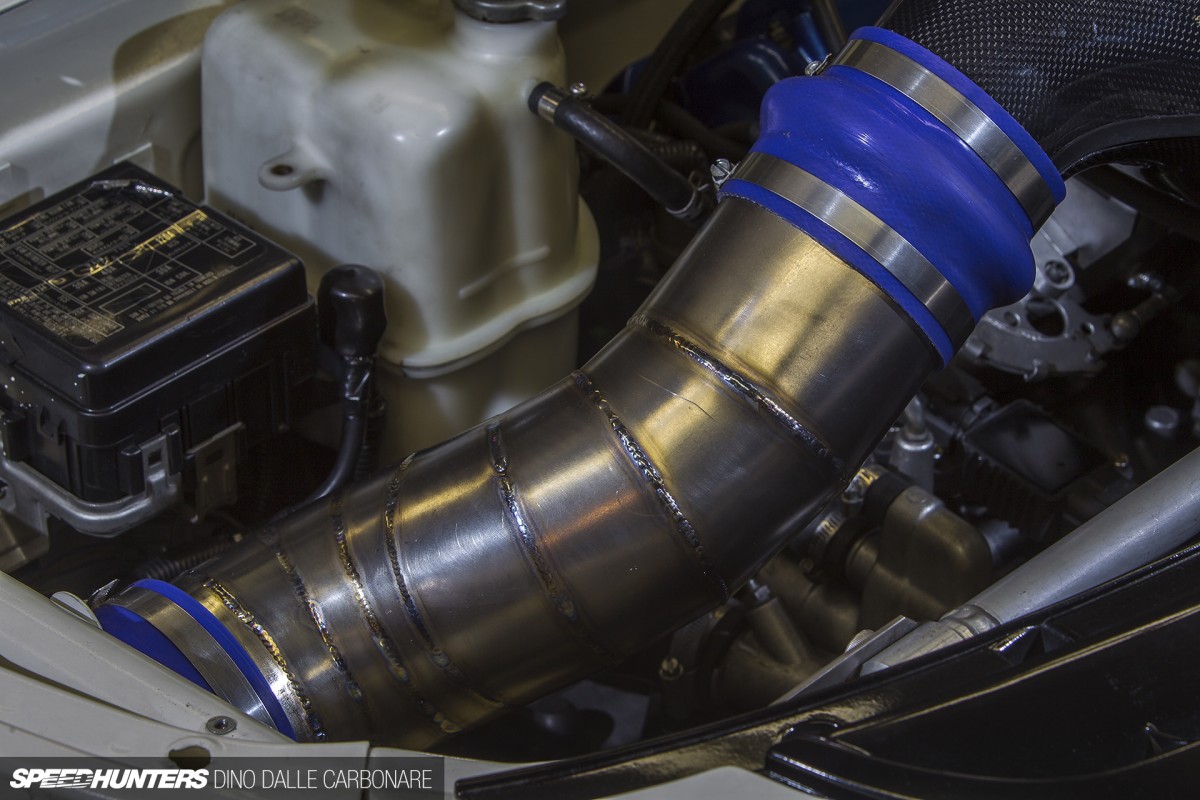
The sealed box is fed air through the passenger side rear intake and at speed can actually generate positive pressure, giving a little sort of ram-air effect.
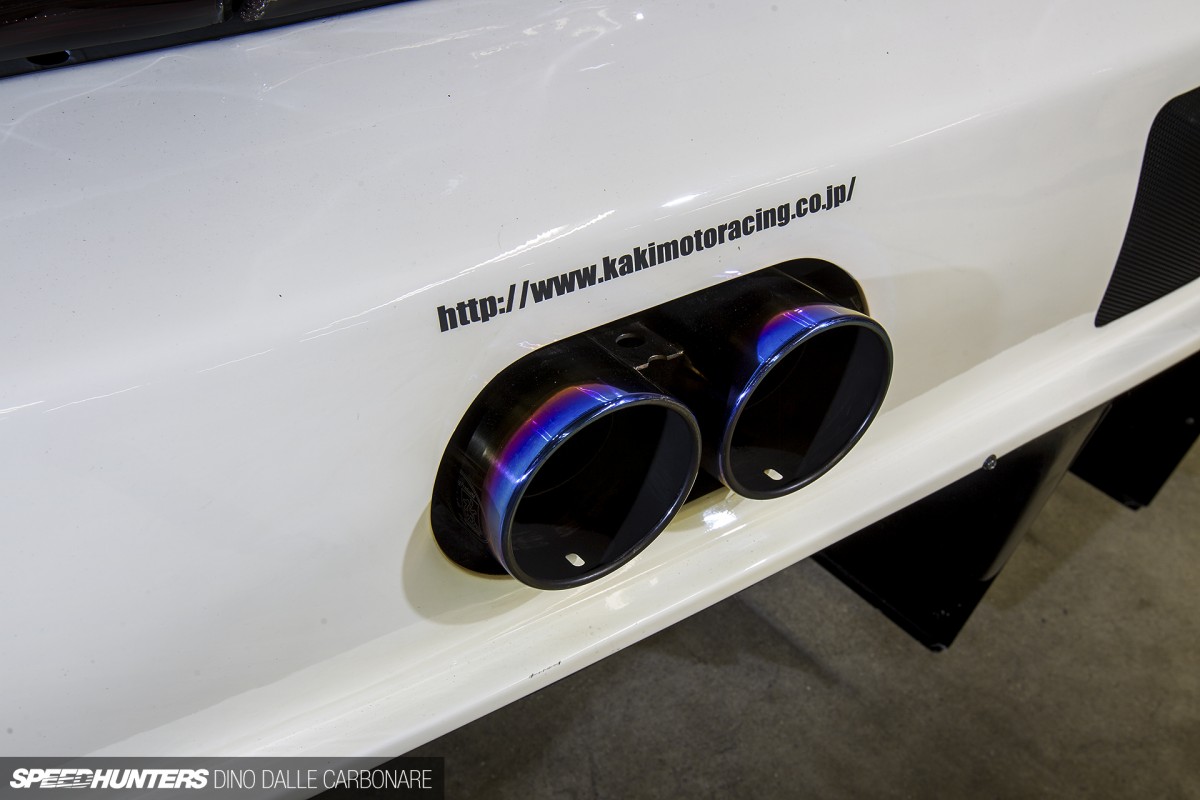
With any high-strung naturally aspirated motor, the fine balance between intake and exhaust is key at getting the most out of a particular set-up. How may times have you heard stories of people bolting on big bore exhausts to their NA car and losing both power and torque? Being one of the most respected custom exhaust makers in Japan, this was not going to be a problem for Kakimoto, who devised a set of intricate headers which dump gasses into a center-exit single pipe topped with a pair of titanium-coated tips. This creates the exact backpressure the engine needs to maximize its power and torque outputs which top out at 345hp at 6,900rpm and 362.8Nm respectively.
If you’re wondering what that sort of engine set-up sounds like, it’s a good thing French Magazine Autoworks caught the car out testing in mid-2012. As you can see, they were still working on the aero package back then but that sound – wow!
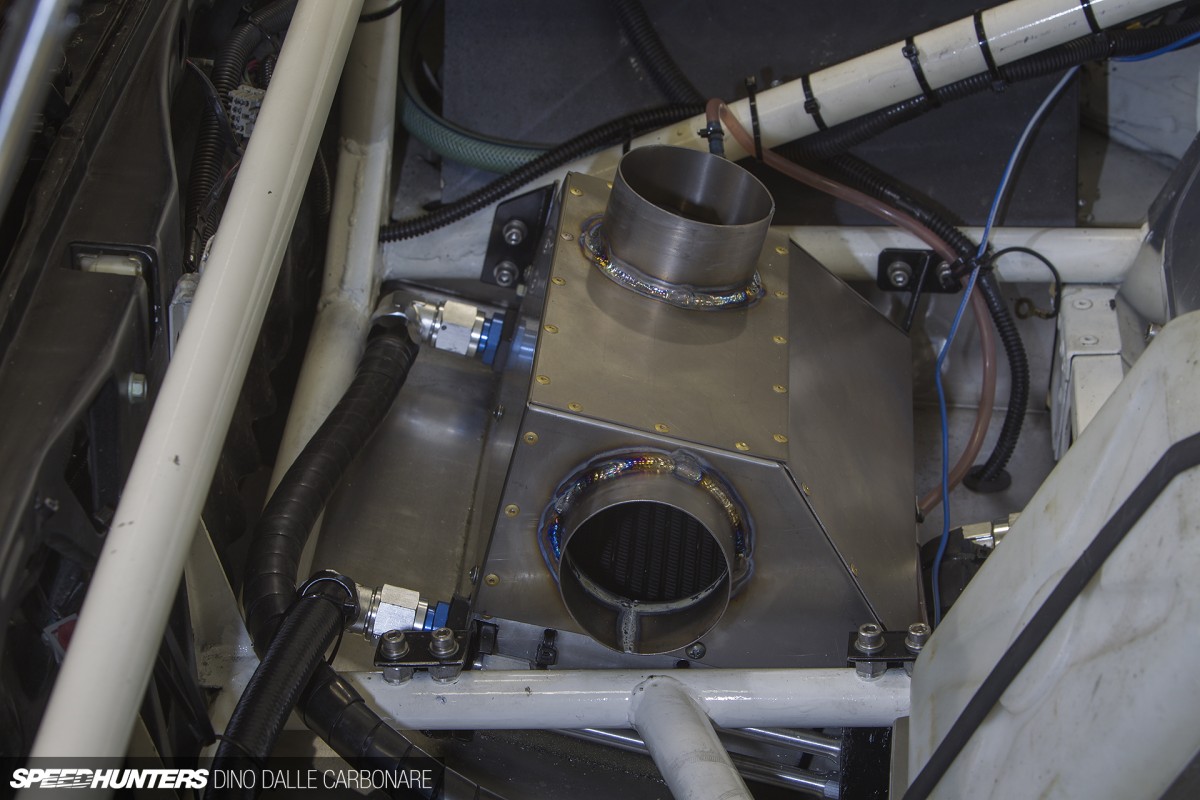
The driveline followed, and along with the Exedy twin plate clutch a NA2 six-speed transmission was fitted. This sends drive via a shorter final drive to the ATS two-way LSD, a set-up that further boosts the engine’s explosive nature. To guarantee reliability and longevity, Kakimoto even devised their own transmission cooler made up of a small baffled radiator, mounted inside the trunk area and fed by the two NACA ducts on the lid.
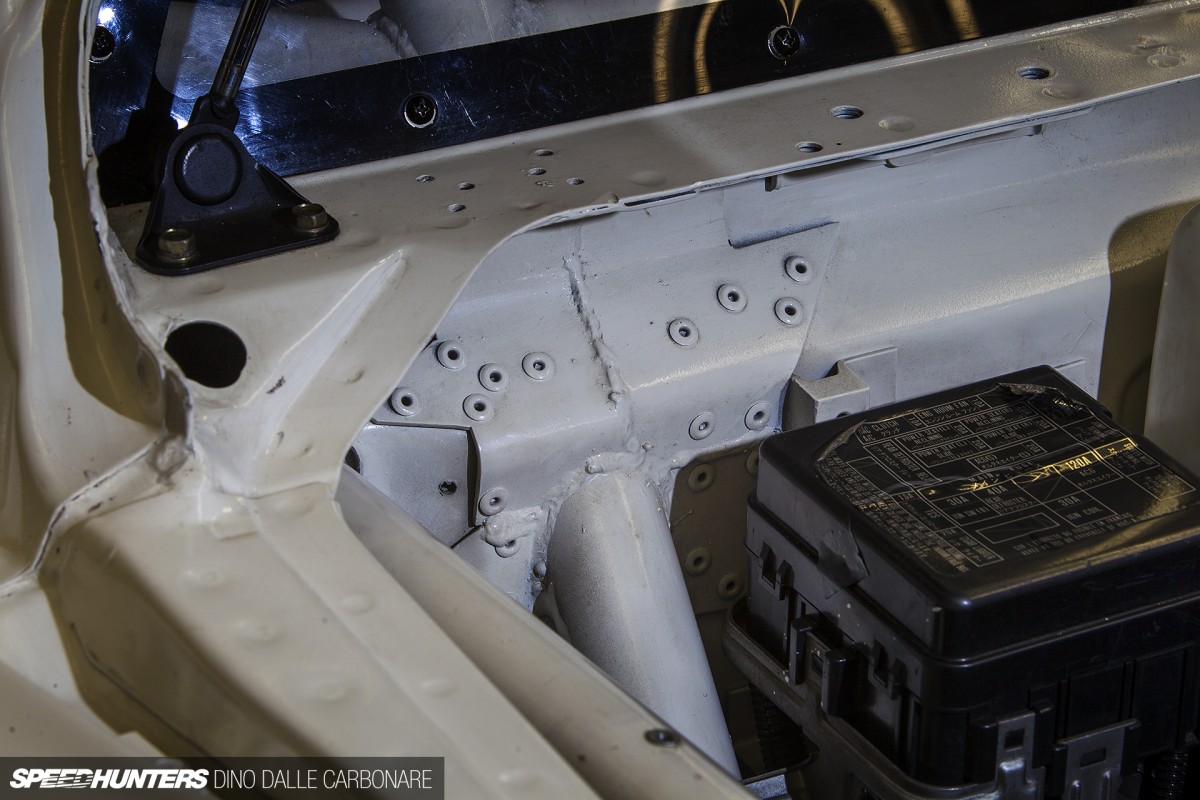
Additional stiffening of the chassis was also carried out in the engine bay and rear portion of the car, and like up front, bonding and riveting was required to merge the steel pipes to the aluminum frame.
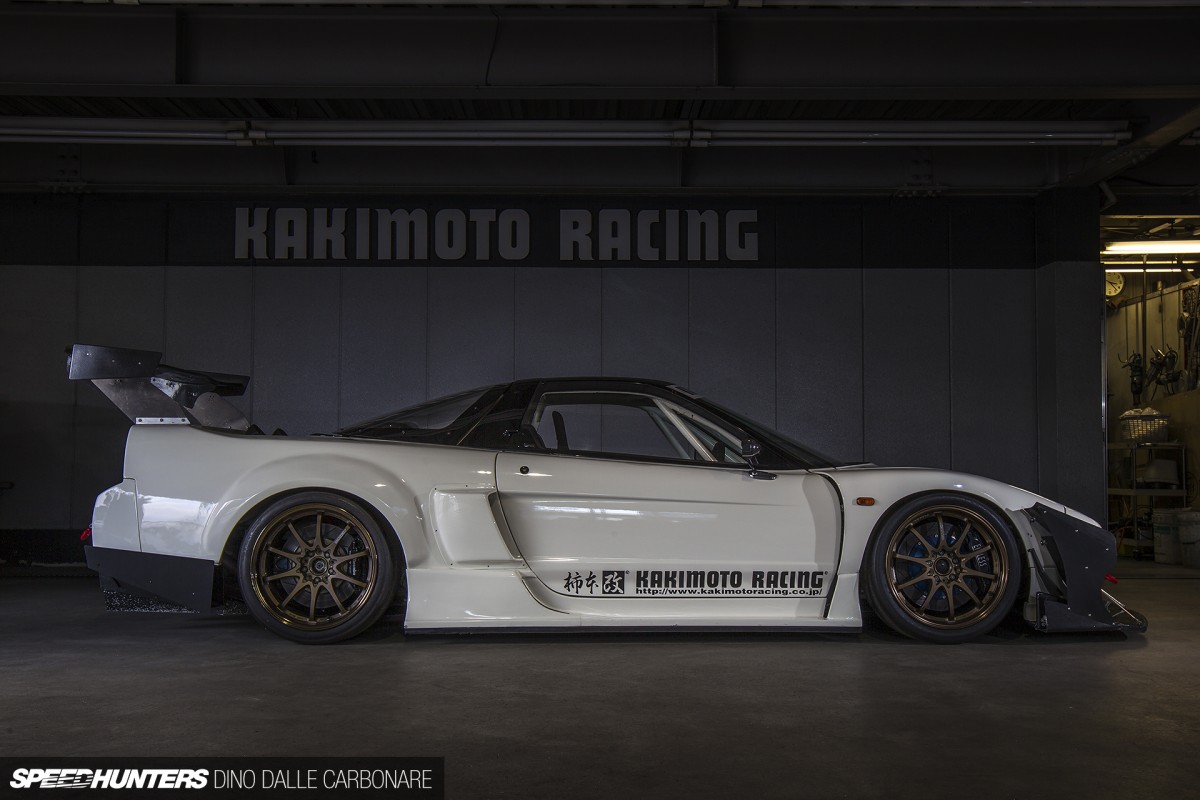
This NSX is very much a work in progress, a way for Kakimoto to have some fun on the side while getting their name out there. It’s something they have always done in their close to forty year history and something they will continue to do in the future. After all, as they say, ‘Racing improves the brand!‘
Dino Dalle Carbonare
Instagram: speedhunters_dino
dino@speedhunters.com






this reminds me of something from team top end running the wangan... but way cooler. i love the body work.. man dino you've been putting out alot of good features... and its only the middle of feb lol. we are going to have an interesting 2014 indeed!
beautiful car and a very good example of excellent engineering at work without creating something that only wears the face of the factory car. Those velocity stacks and intake chamber is a work of art as well; good job Dino.
@goon Thank you Sir
d_rav Ah Top End!! Classic stuff! Loved seeing their NSXs at Daikoku back in the day. Thanks!
I'm speechless.
I love the engine setup on this beauty, velocity stacks were an awesome choice to go by. Love the video and that sound!
I love this car, but why make a engine good for 9000 rpm, and then max HP at 6900rpm ?
One day.......
Thanks for going into such great detail on this one Dino. Very much appreciated. Love cars like this that are just built for the pure joy of it. Brilliant work Kakimoto!
Ealoken The point would be that most cars fall out of their peak power after upshifting in a similar fashion that turbo cars can fall out of boost at lower RPMs. They allow the car to be at peak power after shifting by spacing it away from the redline. I'm sure if their ecu tuning is as robust as the mechanics of this car, the power curve most likely doesnt drop much after peak power.
I would like to thank SH for improving the presentation mode vastly. It seems that you are reading the Feedback section after all. The previous one was unbearable, but this one is really good and I really like the fact that you can hide the text on demand by pressing the forward arrow. I am going to use it from now on.
With regard to the feature car, I really enjoyed both the text and images.
Great car, and a great engine, and altough it is technically correct because there is a diffuser in front of the wheels the extended lip is called a splitter
andrewhake Remember the engine/trans is in the rear, the high rate will help with rotation.
I guess it's a curse of being an engineer but I'm going to have to call foul on their roll cage chassis integration. I don't know what kind of bonding agent they might have used (I can't see any in the cage landing pads) but those are certainly not structural rivets. No structural rivets have a hollow mandrel since it degrades performance in the rivet's shear plane. Time attack cars don't usually have to meet the same saftey regs as wheel to wheel race cars but if I was the tech inspector I'd fail this car immediately. The cage on this car is marginally better than nothing at all but is truly not safe.
Google some pictures on how Prodrive integrates the roll cages on the Aston GT4 cars or how Lotus does the same on the Evora. That will provide some reverence on how to do it correctly.
JorgeMoreira1 There is no front diffuser on this car. There is a splitter followed by a flat undertray. A true front diffuser looks like: http://www.mulsannescorner.com/gtone-1.html
What a great feature to introduce the new Presentation mode, very nice update to the site.

I love the car, although the riveting seems a bit odd to me. Many race cars run into this and AFAIK, they tend to bold in the entire cage on massive brackets, same for the tubbed front clip. I quite appreciate how the car has kept a sense of it's origins without compromising on what it has now become.
Dino, that's a great shot of the engine bay shot with the overlayed velocity stacks in the carbon airbox, can't wait for the shop tour
shiftyXTI Thanks, glad you like the car! And the new presentation mode is nice uh:)
wheatgod Purists?
marshalljung Can't find any images of rivets but you are right, they simply seem to just bolt them onto the Al frame
@Seeking Perfection Thanks, glad you like it:) But wait, does that mean you don't read the text!!! lol
andrewhake Thanks, happy to head you liked it. Yeah apparently the weight of the engine and the big rear downforce calls for such spring rate. I wonder if they have the same issue like the Esprit NSX had at WTAC where the rear tyres would overhead after a lap or two
tokuku
kphillips9936 Yep the NSX has always craved a six-throttle set up!
Damn!
marshalljung lots of pictures but none that I found that specifically show the how part you reference. Any shots/links you know of?
I just noticed something, the picture with the intake box showing the funnels, is it transparent or am I just seeing things 0_0
Likewise, badass build!
@zz It's just a fade out effect done in the editing to illustrate the intake funnels. You can see it's carbon fiber in other pictures.
A functional NSX with ITBs? I think I'm in love.
Why didn't they just weld aluminum plate to the chassis, weld an aluminum pipe(schedule 40) to that plate, with a flange welded to that pipe. They could do this at every point the steel was tobe mounted to the chassis, and have an equivalent steel flange to bolt to the alumminum mounting points. The rivets just look ratchet as hell, from a welder/fabricator's perspective. Other than that, great car and good article
louisiana jake Thanks! Guess they didn't know that method
Wildcardfox Yeah it's there to show you how the funnels look under the carbon air box cover As far as I know semi-transparent carbon hasn't been invented yet hihi
As far as I know semi-transparent carbon hasn't been invented yet hihi
wheatgod speedhunters_dino Depends what you wanna do with the car. For this application, NA is the way IMO
speedhunters_dino shiftyXTI Any ideas as to why my presentation mode has stopped working? it's only happened in the last week or so... just doesn't do anything when i click on it. the download wallpaper button still works though
I agree with Louisiana Jake, I've found using the 'bond and rivet' method, over time the mounts 'pull out' and break due to fatigue, and in areas of increased heat, the bonding releases, often in as little as one heat cycle.
Im sure this was a lovely article, but your grammar and pretty poor and I didnt read past the bit with the carbon lip/canard. sorry
This is mental! Just everything about this car screams pure grassroots racing. So much time was devoted to detail and function. I wish more cars were like this. The engine bay has quality written all over it, But the front end is beyond my wildest dreams. This is definitely a car I have to see, its just pefection in all ways, specially functionality though.
AlexBailey speedhunters_dino Thanks man. I hope they enter the car in Super Battle this year!
achinaghost52 Examples?
Honda p*rn.
@reallyknt marshalljung I have some shots from my last visit to Prodrive's shop in Banbury, but they are just on my computer. For reference please see page 4-31 in the FAA metal repair and fabrication guide here: http://www.faa.gov/regulations_policies/handbooks_manuals/aircraft/amt_airframe_handbook/media/ama_Ch04.pdf
When in doubt use aircraft engineering standards and adhere to the rulebook of the sanctioning body in charge of the racing group.
@reallyknt marshalljung I have some shots from my last visit to Prodrive's shop in Banbury, but they are just on my computer. For reference please see page 4-31 in the FAA metal repair and fabrication guide here: http://www.faa.gov/regulations_policies/handbooks_manuals/aircraft/amt_airframe_handbook/media/ama_Ch04.pdf
When in doubt use aircraft engineering standards and adhere to the rulebook of the sanctioning body in charge of the racing group.
@reallyknt marshalljung Edit: I found one of the Lotus: http://turbolive.ru/wp-content/gallery/lotus-planning-hardcore-evora-racer-for-the-road/lotus_evora_type_124_front_3qtrs_interior_1.jpg
Hopefully you can view that.
Gareth36 speedhunters_dino shiftyXTI Really? What platform/browser are you on? Still have issues?
marshalljung thanks, excellent shot. Would be nice to know what type of bond they use, you're spot on there. Possible (not sure why, but possible?) it was bonded, then painted? Even in presentation mod, I can't seem to get a close enough pic of the hardware used - your pics are much better in that regard. But sounds like you work with this stuff often, so have a keener eye as to what to look for. I wonder what the WTAC and SuperLap regs call for, would be interesting to read
marshalljung ok now I see it - in download mode. You're right, doesn't appear to be any bonding agent used
would it matter what the underside of the car looks like? For example if there, perhaps any plates that the rivets connected to? Would mean an awfully long rivet, which in itself may not be safe, but just curious
they converted the front double wishbones to macpherson strut...
Got one of the Aston as well: http://www.pistonheads.com/pics/news/16362/n24d-web-L.jpg
@reallyknt marshalljung Thanks for responding and asking questions. I like engineering but we all have to keep in mind we are arguing or critiquing photos on the internet, so grain of salt and all that.
With regards to this instance of cage manufacture I don't know the rules of racing that govern this Japanese car. So what they have might be OK. However, my experience with SCCA, NASA and FIA certification clearly frown on this methodology.
Backing plates are a good way to attach a cage to dissimilar unibody material. Provided that the plates on both sides are large enough to spread the load across the material (aluminium) taking into account the shear strength of the aluminum. One must also use the appropriate fasteners. Bolts can be used or structural rivets or epoxy or a combination. The key is to know the tensile and shear characteristics of the fastening method and size appropriately.
The whole palava I may have started was to observe that the rivets used here are not structural rivets. Structural rivets do not have hollow mandrels (the core bit that pulls through and then is snapped off or peened over). "Pop" rivets that one might use to fasten body panels or interior bits do usually have hollow cores so that you can set them using a hand rivet tool. "Pop" rivets are not rated for shear or tensile applications where any appreciable load is generated. Next time you take a flight look at all the flush mounted rivets used on any aircraft. I guarantee none of those are hollow mandrels.
While the cage on this car might be stiff to the hand, in any major accident those mounting plates will shear off creating the un-enviable situation of having a semi-detached tubing structure bounding around in the car with the driver and no additional protection than what the car offered stock.
speedhunters_dino achinaghost52 lmfao, points out your grammar (which was fine, this isn't a doctoral thesis), but uses poor grammar himself
This car was bonded/riveted...won Leman and multiple championships...